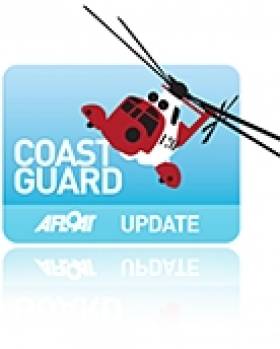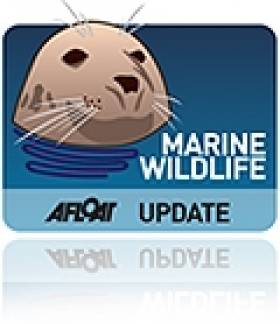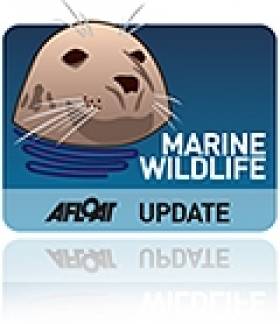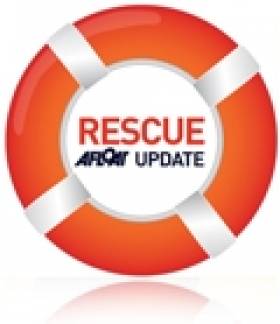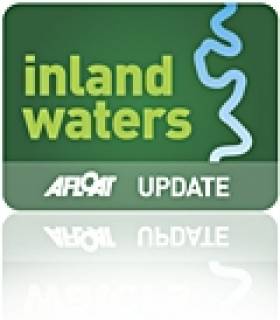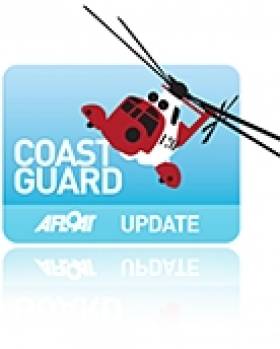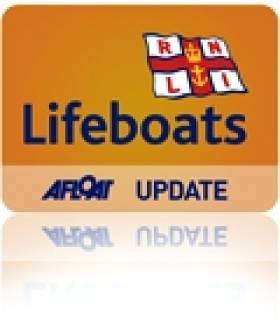Displaying items by tag: Rescue
Search for Missing Seafarers Finishes for the Night
Four lifeboats, four helicopters, three coastguard rescue teams, two merchant vessels and a fixed wing aircraft have searched an area of approximately 300 square miles today. However, sadly the only sign of the missing seafarers has been their two liferafts, a lifebuoy from the vessel and a survival suit.
In the early hours of this morning two seafarers were airlifted from the sea and a third person was found, but sadly he was deceased.
The 81-metre cargo carrier, 'Swanland' broadcast a mayday message at 2.00 am this morning. The ship reported that their hull was cracking, due to bad weather and that they thought that it may be taking water. Holyhead Coastguard broadcast a mayday relay and several vessels responded. Two of these vessels were able to go to the assistance of the Swanland and its eight crew. When the two vessels arrived at the scene, they found two liferafts and some floating debris. They were able to provide shelter from the gale force winds, whilst awaiting the arrival of rescue resources. Meanwhile Holyhead Coastguard had scrambled two rescue helicopters and requested the launch of two lifeboats.
When the helicopters arrived on scene they found two crew members in the water clinging to the liferafts. These two were airlifted from the sea into the RAF helicopter and taken to RAF Valley. A short while later a third person, who was deceased was found. The search is continued throughout the day for the other five with additional rescue resources being added as the day progressed
Holyhead Coastguard Watch Manager Mark Craddock says:
"Sadly, despite a 14-search involving land, sea and air assets, we have not been able to find any sign of the missing men. As darkness draws in we are releasing the rescue crews."
Search Continues for Six Seafarers Missing on the Irish Sea
#RESCUE–Holyhead Coastguard is currently coordinating the search for six merchant seafarers who are missing in gale force weather 10 miles west of the Lleyn peninsula, Gwynedd.
The 81-metre cargo carrier, 'Swanland' broadcast a mayday message at 2.00 am this morning. The ship reported that their hull was cracking, due to bad weather and that they thought that it may be taking water. Holyhead Coastguard broadcast a mayday relay and several vessels responded. Two of these vessels were able to go to the assistance of the Swanland and its eight crew. When the two vessels arrived at the scene, they found two liferafts and some floating debris. They were able to provide shelter from the gale force winds, whilst awaiting the arrival of rescue resources. Meanwhile Holyhead Coastguard had scrambled the two rescue helicopters from RAF Valley and Dublin Coastguard and requested the launch of the Pwllheli and Porth Dinllaen RNLI all weather lifeboats.
When the helicopters arrived on scene they found two crew members in the water clinging to the liferafts. These two were airlifted from the sea into the RAF helicopter and taken to RAF Valley. The search is continuing for the other six. The original two helicopters have now been replaced with a helicopter from RAF Chivenor and an Irish Coastguard helicopter.
Holyhead Coastguard Watch Manager Jim Green says:
"We are very concerned for the safety of the other six crew members. We know that at least some of them are wearing immersion suits and have strobe lighting with them, however sea conditions are challenging at best.
The cargo vessel had 3000 tonnes of limestone onboard. It appears that it may have sunk."
Dolphin Rescued in Co Wexford
#MARINE WILDLIFE - A stranded dolphin was rescued at Duncannon on Monday last week, the New Ross Standard reports.
After being spotted by a member of Fethard-on-Sea RNLI, the dolphin was aided by the lifeboat crew, with advice from the Irish Whale and Dolphin Group.
The juvenile dolphin, who appeared to show no distress from the incident, was taken out to see and released in deep water off Templetown strand.
A spokesperson for Fethard-on-Sea RNLI said the crew were "'especially pleased to have undertaken such a rescue mission with a successful outcome".
Common Seal Pups Rescued in Dublin
#MARINE WILDLIFE - Seal pups Rebecca and Emma had a curious audience of tourists at Malahide Castle earlier this month as they prepared for their relocation to Dingle, where they will be cared for by Irish Seal Sanctuary (ISS) volunteers.
The pups were rescued from different parts of north Dublin. Both were found very ill at the time, but according to the ISS, volunteers rallied to their support, providing much needed fluids for rehydration before their long journey south.
Rebecca is named after the daughter of her rescuer, ISS volunteer and Howth businessman Jon Cooke. Meanwhile, Emma was rescued by one of the founder members of the ISS, Johnny Woodlock, from the beach in Skerries.
The ISS added that it is grateful for the sponsorship of the rehab season the Dingle Wildlife and Seal Sanctuary is providing for the seal pups' care.
Man Rescued from Sinking Boat at Galway Docks
The Irish Coast Guard and Galway RNLI lifeboat were alerted and came to his assistance when his eight-foot RIB broke down near Nimmo's Pier around 5pm.
The man was taken safely on board and the RIB was towed to the slipway at the new Ocean Sports Centre. No serious injuries were reported.
Search and Recovery Operation Underway at Banagher Bridge
Waterways Ireland request masters of vessels to proceed at slow speed and with minimum wash when in the area to avoid hindering or upsetting the search craft.
Lough Derg Lifeboat Rescues Five People from Cruiser on Rocks
At 09.49hrs the lifeboat launched, with helm Eleanor Hooker, Peter Clarke and Colin Knight on board. The lifeboat carried its salvage pump. The wind was southwest, Force 3 to 4 gusting 5 (9knots gusting 18), with visibility very good. At 10.12hrs the lifeboat was alongside the casualty vessel which was listing severely to starboard and on rocks. There were five persons on board, all safe and unharmed and wearing lifejackets. Two RNLI crew members went on board to assess damage to the vessel and, finding that she was holed and taking on water, it was decided to take all persons onto the lifeboat and transfer them to Castle Harbour where they were met by the rest of their group. The lifeboat thanked the skipper of Laura for standing by. The lifeboat returned to station and was ready for service at 12midday.
Angler Rescued after Fall from Cliff
At just after 1pm Liverpool Coastguard received a 999 call from a member of the public who had witnessed the person fall in to the sea from cliffs adjacent to the historic St. Ninians Chapel. They immediately sent the Coastguard Rescue Team from the Isle of Whithorn, the Royal Navy rescue helicopter from Prestwick and the RNLI Lifeboat from Kirkcudbright.
As the Whithorn Coastguard team arrived on scene, members of the public were just bringing the person ashore. He is believed to have sustained a broken leg and head injuries in the fall. He was winched on board the helicopter and taken to Crosshouse Hospital near Kilmarnock.
Tony Topping Liverpool Coastguard Watch Manager said:
"We're not really sure how the angler ended up falling from a ledge in to the sea but cliff edges are dangerous places and we would ask people to take particular care.
"If you are walking along coastal paths make sure that you are properly equipped. In particular remember to wear sturdy shoes or boots and check the weather forecast before you set out. Do not attempt to climb up or down cliffs unless you are properly equipped and trained to do so. Do not attempt to climb cliffs as a short cut back to the top. Do not attempt self rescue. If you get into difficulty, call 999 and ask for the coastguard.
Red Bay Lifeboat Join in Search for Ballycastle Woman
The volunteer lifeboat crew assisted in an intensive shoreline search today along the coastline around Ballycastle from Fair Head to Kinbane head.
The lifeboat was joined in the shoreline search by local Coast Guards and the Police helicopter in the search, which lasted several hours.
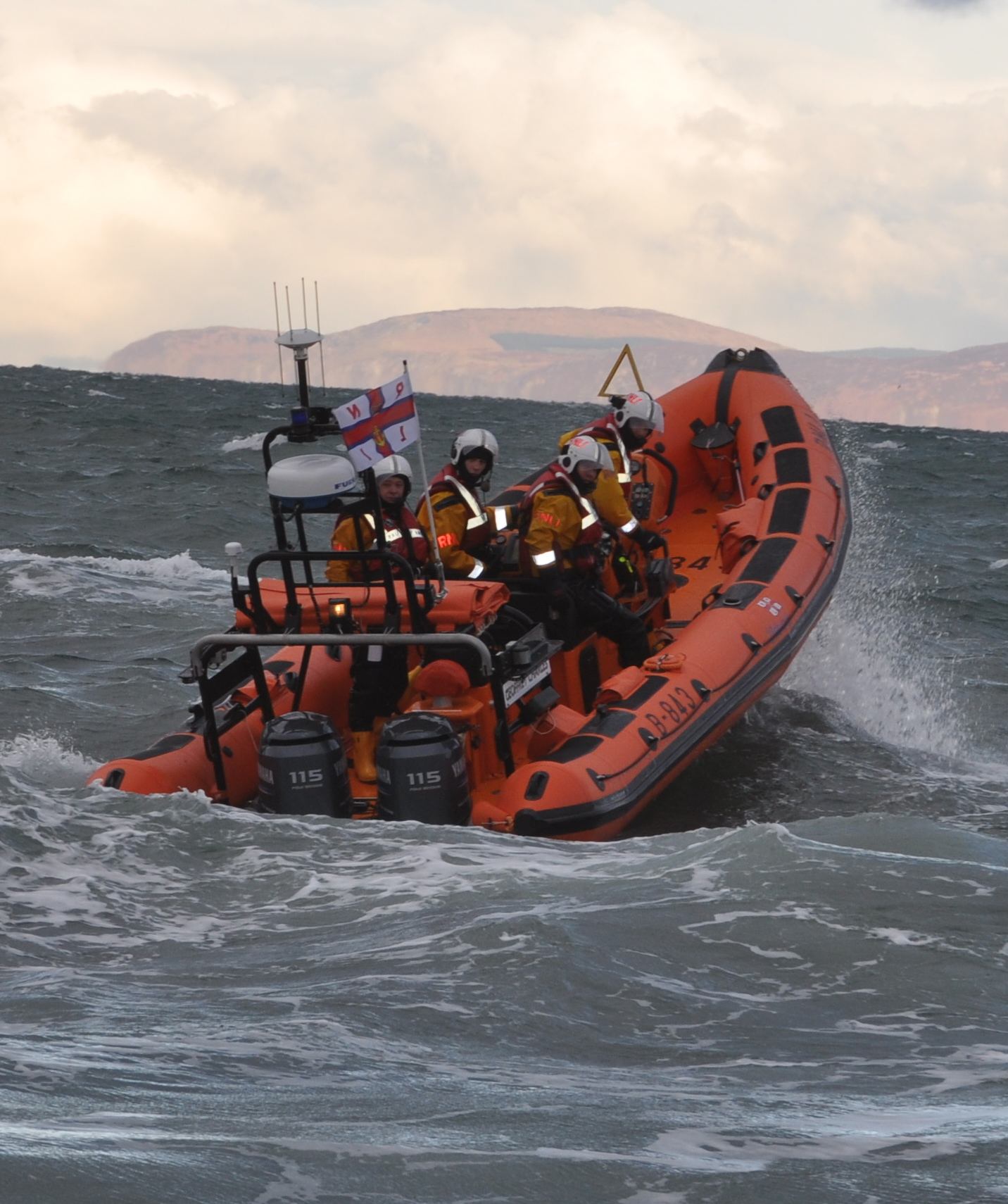
Red Bay RNLI Lifeboat searching near Ballycastle
Weather conditions for the search were difficult with strong gusty winds.
Nothing was found in the operation, which lasted several hours.
The search continues throughout the Ballycastle area.
Seven New Coast Guard Boats in €2M Safety Programme
€1.5 million has been allocated for 7 new Coast Guard boats as part of its boat renewal programme;
€300,000 will be used to purchase new vans for the Coast Guard's volunteer rescue teams;
€200,000 will be used to update the Coast Guard's pollution response equipment to best international standards.
Separately, Minister Varadkar is backing an Irish Coast Guard initiative to have a new European Coast Guard Secretariat based full-time in Dublin.
Speaking today, Minister Varadkar said: 'I'm very happy to allocate extra resources to the Coast Guard to upgrade its vital equipment, including seven new boats, along with replacement vans and pollution control materials. One of the new Rigid Inflatable Boats (RIBs) has been allocated to Achill Coast Guard, and the remainder will be allocated to Coast Guard Stations around Ireland over the next 12 months, according to priority.
"Everyone who goes to sea owes a debt of gratitude to the Coast Guard, as do their family and friends. The Coast Guard responds to emergency call-outs, and saves lives, at all hours of the day and night, throughout the year. Much of the Coast Guard's work is only possible through the large network of individual and group volunteers."
Minister Varadkar also congratulated the Director of the Irish Coast Guards, Chris Reynolds, who has been elected the new Chair of the European Union Heads of Coast Guard. The annual Heads of Coast Guards of Europe's meeting will now take place in Dublin next August.
Mr Reynolds has been asked specifically to prepare the ground for a permanent Secretariat, manned by Coast Guard Officers from Member States, the EU Commission and various agencies. The Secretariat will meet in Dublin for its inaugural year, and Mr Reynolds will propose to have the Secretariat based in Dublin on a permanent basis.
Additional info:
New Delta 900 SUPER X RIBs for Irish Coastguard
The Irish Coastguard's new Delta 900 SUPER X Coast Guard RIBs are 9.00m overall and will be in service off the Republic of Ireland's coast.Jun 07, 2011 - From its early days in 1979, the Delta Power Group (builder of Delta RIBs) has grown to become one of the most successful and highly regarded designers and builders of commercial RIBs for the world market.
This enviable position has been achieved through a simple business philosophy. Delta has not burdened itself with debt to fuel growth, preferring to expand organically by concentrating on contracts that remain strictly within its targeted commercial sector, winning business from successful organisations; which in turn generates repeat orders and new contacts.
A recent Irish Coastguard contract is not for just one craft; but covers a five year programme to supply 12 highly specified boats. Delta's Military and Law Enforcement range comprises nine models and these are offered with different specifications depending on usage.
The Irish Coastguard's new Delta 900 SUPER X Coast Guard RIBs are 9.00m overall and will be in service off the Republic of Ireland's coast. Twin Yamaha F225B engines give a maximum speed of 40 knots and a cruising speed of 32 knots. Safety equipment is to MSO P6 Passenger Boat and other equipment is to MCA Category 3 rating. The extensive specification includes Shockwave mitigating seating for all the crew. And it also features Delta's standard procedure of terminating all wiring looms in fully waterproof housings with Deutsch connectors to ensure maximum in service reliability; essential, since the Irish Sea and Atlantic Ocean can throw up very demanding operational conditions.
In addition, Delta is one of the few major Commercial RIB builders to run the processes of laminating, tube making and outfitting completely 'in house' (on its wholly owned and secure 2.2 Acre freehold site) in 79,000 sq.ft of covered space. This ensures maximum Management and Quality Control. Delta is certified to ISO 9001: 2008 and is able to build under full survey of all the major Classification Societies.
As a result, Delta's extensive international client base now includes ERRV, Marine Police, Border Control, Customs & Excise, Navies, Special Forces, Coastguards, Search & Rescue services, Law enforcement agencies, Military and Port Authorities; to name just a few.



























